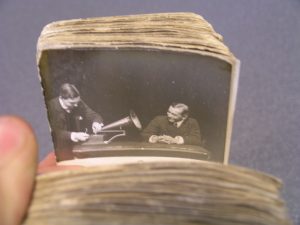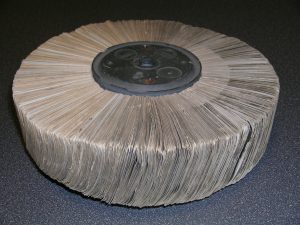Secrets of the EMI Archive – 1
‘Nipper Runs Amok’
By David Hughes MBE – Trustee of EMI Archive Trust.
Archives and secrets go together, and the EMI archive is no exception. Archives are not visitor attractions; they are not laid out beautifully in lovely display cabinets. The key words are preservation and safety. Initially, presumably, for good business practice, The Gramophone Company (its name until in 1931 it merged in recession with its great rival Columbia to become Electric and Musical Industries – EMI) kept copies of all its paperwork from the day in 1897 that William Barry Owen was sent by ship from New York to London to sell the newly invented flat record disc.
122 years later, that archive still exists – a unique record of one company’s history and preserved by a Trust, unlike those of its many rivals over the years, which sadly have disappeared with take overs and liquidations.

EMI Archive Trust Museum Store
In this series of blogs, we want to give you a tiny taste of some of the treasures that lurk within our walls, be they paperwork or artefacts, and will start with one of the quirkiest.
Those of you who were children of the 1940’s and 1950’s, for whom British seaside towns were out holiday destinations, will remember the pier with its wonderful penny-in-the-slot machines, candy floss and greasy fish and chips.

This Mutoscope was commissioned by the German branch of the Gramophone Company, and sent to the London branch in October 1900. Part of the EMI Archive Trust collection.
The biggest attractions were the ‘What the Butler Saw’ machines, so called because they largely featurely (not very) scantily dressed young ladies being totally innocuous, but were marked ‘for adults only’. Their official name was the mutoscope. The movement was created by hundreds of still images, taken in quick succession and fixed to a central hub. The penny in the slot released the mechanism and turned on the light, and by slowly turning the handle, the photographs became animated and the young ladies moved and danced. The art was the make the experience last as long as possible by turning slowly!

‘Nipper runs Amoke’ spool comprises of 700 photographs mounted onto cards and attached to a drum wheel, when the drum is turned in a ‘What The Butler Saw’ type of machine, it gives the impression of movement. Part of the EMI Archive Trust collection.
Fast forward many decades and a strange spool of such photos was unearthed in one of EMI’s offices. Not of a dancing lady but of “Nipper”, the famous dog featured in Francis Barraud’s iconic painting “His Master’s Voice”, to which we will return in future blogs. Of course, the dog featured wasn’t Nipper – he’d died even before Mr Barraud painted him! – but seemingly The Gramophone Company in Germany, for totally unexplained reasons, chose to make the mutoscope with a dog and a gramophone. What their intentions were and what they expected to happen remain two of life’s many mysteries, but we can only assume it was not what actually happened! Why was it made; where did the mutoscope reside- not on a seaside pier, that’s for sure – the Germans aren’t renowned for their beach holidays!
Have a look. It’s called Nipper runs amok (another mystery – by whom?) and it’s a hidden gem.
